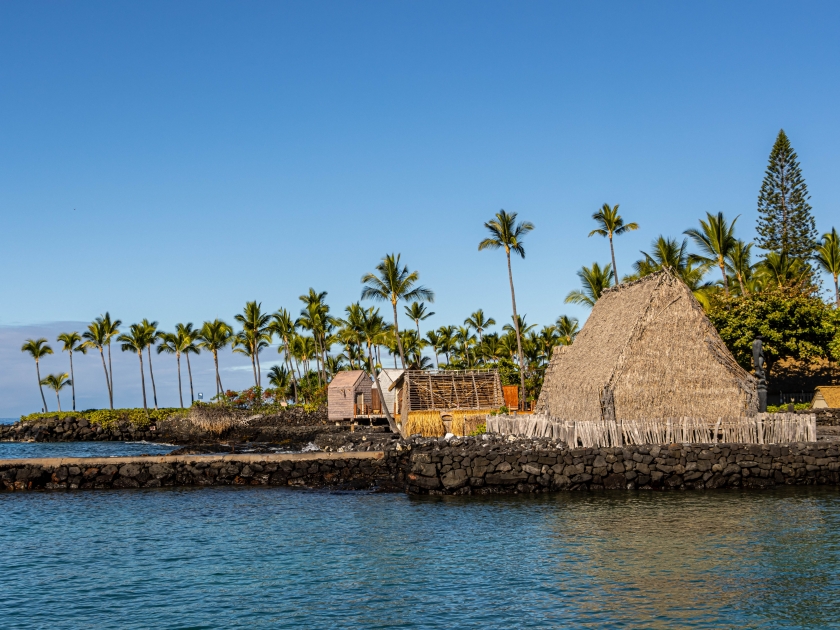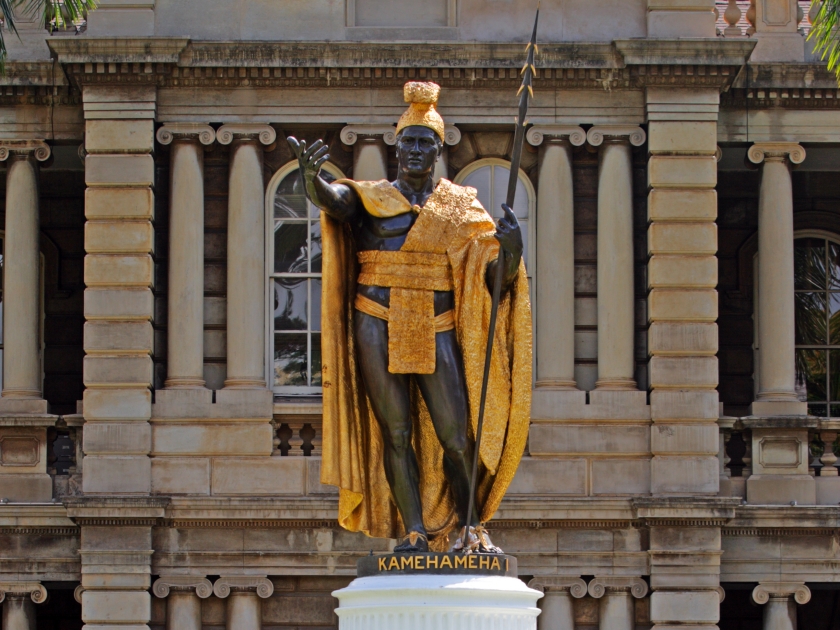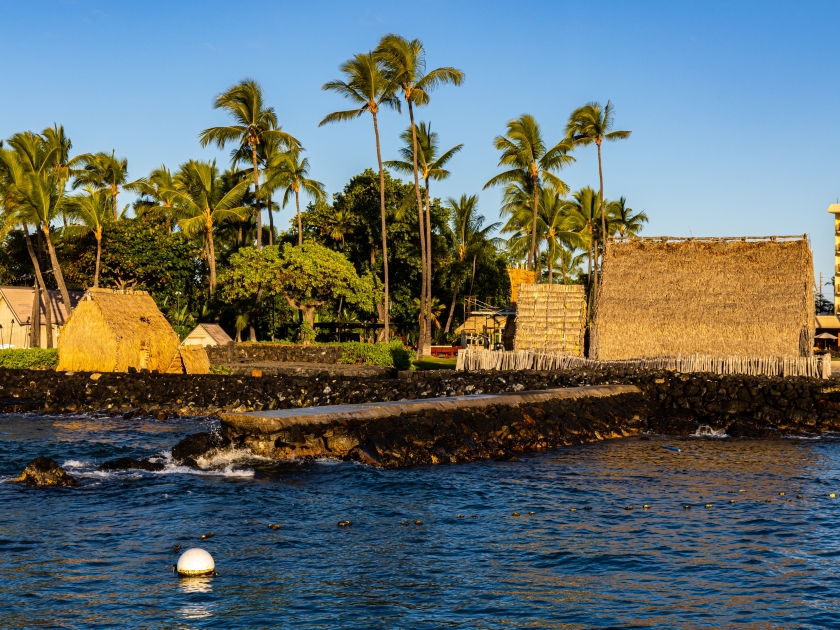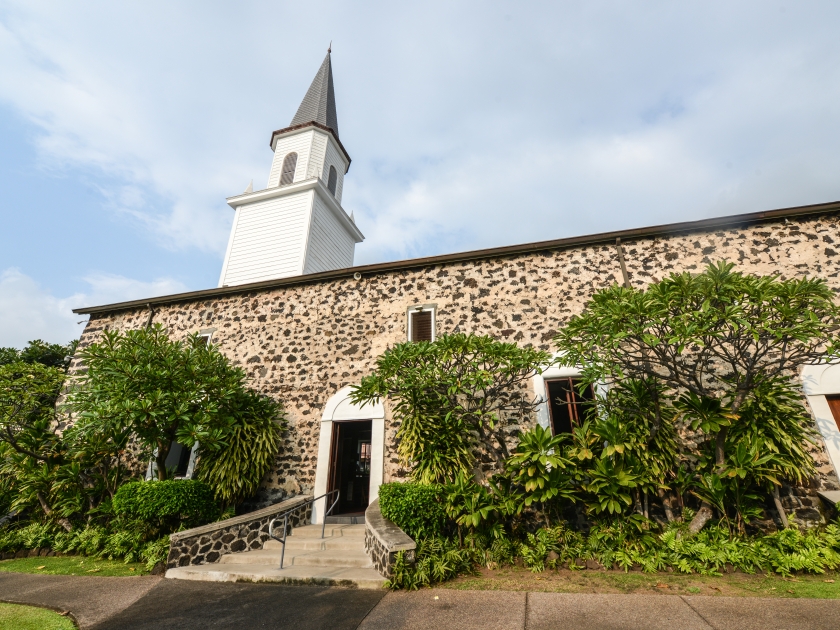On the serene coastline of Kailua Bay on the Big Island of Hawaii, the Kamakahonu National Historic Landmark holds a revered position in Hawaiian history. Once the residence of King Kamehameha I, the Great Unifier of the Hawaiian Islands, this sacred site features prominently in the cultural tapestry of Hawaii. Kamakahonu, or “the turtle eye,” offers visitors a unique glimpse into the rich heritage and traditions that have shaped the islands. This guide aims to unveil the majestic allure of Kamakahonu, exploring why it remains an essential pilgrimage for those seeking to immerse themselves in the true spirit of Hawaii.
Highlights
- Experience the profound cultural and historical significance of Kamakahonu.
- The site boasts spectacular ocean views and sunsets.
- Explore the meticulously restored Ahuʻena Heiau, a sacred temple used by King Kamehameha for religious ceremonies.
- Engage with Hawaii’s living culture through interactive demonstrations and performances.
- Opt for a guided tour to gain expert insights into the history, significance, and stories behind Kamakahonu and its surrounding area.
- Kamakahonu’s proximity to the vibrant town of Kailua-Kona allows visitors to combine historical exploration with modern Hawaiian life.
- The adjacent beach offers a chance for relaxation and recreational activities.a
History

A Glimpse into the Past
Constructed around 1812, Kamakahonu was the setting where King Kamehameha I spent his concluding years, steering the Hawaiian Islands through a period of significant change and consolidation of his rule. The site originally housed a complex of structures including thatched houses designated for chiefs and royalty, along with the Ahu’ena Heiau, a temple that played a central role in the religious and political life of the kingdom. Following the death of King Kamehameha I, a mortuary house was erected close to the heiau, adding to the site’s spiritual significance.
Challenges and Restoration
Over the years, many of the site’s original buildings fell into decay or were lost, marking a period of decline for this historically rich landmark. However, a significant restoration effort took place between 1975 and 1977, focusing on reviving key structures such as the Ahu’ena Heiau and the personal retreat of King Kamehameha I. These restorations have played a crucial role in preserving the site’s historical integrity and cultural importance.
Kamakahonu Today
Currently, Kamakahonu is under the stewardship of a dedicated non-profit organization, which oversees the landmark’s maintenance and public accessibility. While direct entry to the Ahu’ena Heiau is restricted to protect its sanctity, visitors can still marvel at the landmark’s beauty and historical significance. Additionally, artifacts from Kamakahonu are displayed at the King Kamehameha Kona Beach Hotel, situated on the grounds of the historic landmark, providing guests with a tangible connection to Hawaii’s past.
Things to Do
Explore the King Kamehameha I Statue

At the heart of Kamakahonu National Historic Landmark stands the majestic statue of King Kamehameha I, a symbol of Hawaii’s unity and strength. This impressive monument not only honors the legacy of the king who united the Hawaiian Islands but also serves as a poignant reminder of Hawaii’s journey through history. Visitors are invited to reflect on the achievements of King Kamehameha I while enjoying the scenic beauty that surrounds this iconic figure.
Visit the Ahuʻena Heiau

The Ahuʻena Heiau, located within the Kamakahonu National Historic Landmark, is one of Hawaii’s most sacred sites. Once the personal heiau (temple) of King Kamehameha I, it played a crucial role in the religious and political life of the kingdom. Today, it offers insight into ancient Hawaiian spirituality and practices. Preserved with great care, the heiau is a bridge to the past, allowing visitors to connect with the deep spiritual roots of the Hawaiian people.
Join Guided Tours
To fully appreciate the depth of history and culture at Kamakahonu, guided tours are available and highly recommended. These tours provide a comprehensive overview of the site’s significance, from its strategic importance to King Kamehameha I’s unification of the Hawaiian Islands to the sacred rituals performed at Ahuʻena Heiau. Knowledgeable guides enrich the experience with stories and facts, bringing the vibrant history of Kamakahonu to life.
Visit Nearby Attractions

Kamakahonu’s prime location offers easy access to a wealth of nearby attractions. A leisurely walk leads to the historic Huliheʻe Palace and Mokuaikaua Church, each echoing unique facets of Hawaii’s royal and religious history. Kailua Village, buzzing with activity, invites exploration of local culinary delights and artisanal treasures. Additionally, the nearby Kailua-Kona area, with its pristine beaches, provides a perfect blend of cultural exploration and natural beauty, inviting visitors to experience the diverse allure of Hawaii.
Entry Fees and Reservation Requirements, if Any
Access to Kamakahonu National Historic Landmark and its surrounding areas is generally free, allowing visitors to explore much of the site without an entry fee. However, certain special events or guided tours may require a fee or reservation in advance. It’s wise to consult the official website or contact the landmark administration for the latest information on fees and any booking requirements for tours and special access.
Best Times to Visit
Kamakahonu National Historic Landmark welcomes visitors year-round, with its tropical climate offering warm weather throughout the year. The best times to visit are during the spring (April to June) and fall (September to November), when the weather is pleasant, and the crowds are thinner. The landmark is open daily, with hours varying by season; checking the official website or contacting the landmark directly for the current opening hours is recommended before planning your visit.
What to Bring and How to Prepare
Recommended Gear for Your Visit
- Sunscreen to protect against the strong Hawaiian sun
- Plenty of water to stay hydrated throughout the day
- Comfortable walking shoes for exploring the site and surrounding areas
Cultural Sensitivity and Respect for the Site
- Familiarize yourself with local customs and practices to show respect
- Be mindful of the site’s significance to the Hawaiian people
Photography Guideline
- Respect any restrictions on photography, especially around sacred areas
- Use photography to capture memories without disturbing the peace of the site
Travel Tips and Best Practices
- Carry a map or use a digital map app to locate key features within Kamakahonu and the surrounding area
- Identify landmarks and points of interest to visit ahead of time for a more organized trip
- Stay on designated paths and areas to ensure safety and respect the natural and historical surroundings
- Be aware of local wildlife and heed any warnings about ocean conditions or weather
- Follow guidelines and instructions provided by site management to minimize the impact
- Participate in educational programs or volunteer opportunities if available
- Consider donations to organizations dedicated to the preservation of Hawaii’s historical sites
Frequently Asked Questions (FAQs)
The site holds great historical importance as it was the residence and governing seat of King Kamehameha the Great after he unified the Hawaiian Islands. It symbolizes a period of peace and significant political and social changes in Hawaii’s history.
Yes, visitors can tour the Kamakahonu National Historic Landmark. The site is accessible to the public and includes several points of interest, including the Ahu‘ena Heiau, a restored temple, and a statue of King Kamehameha.
Main attractions include the Ahu‘ena Heiau, a sacred temple used by King Kamehameha for religious ceremonies, and a life-sized statue of King Kamehameha. Visitors also enjoy the scenic views of Kailua Bay.
The best time to visit is during the morning or late afternoon to avoid the midday sun. The site is open year-round, but visiting during the dry season (May to October) might provide a more comfortable experience.
There is no admission fee to visit the Kamakahonu National Historic Landmark. It is open to the public free of charge, making it a popular attraction for those interested in Hawaiian history and culture.
Visitors should not miss the opportunity to learn about the historical significance of the Ahu‘ena Heiau and to view the statue of King Kamehameha. Additionally, the site offers beautiful views of Kailua Bay, which should not be missed.
How to Get There
By Car
To reach Kamakahonu National Historic Landmark by car, visitors should head towards downtown Kailua-Kona, located on the western coast of the Big Island of Hawaii. The landmark is situated at the northern end of Kailua Bay. From Kona International Airport, drive south on Queen Ka’ahumanu Highway (HI-19) for about 8 miles. Continue onto Palani Road, which leads directly into the heart of Kailua-Kona. Turn right onto Ali’i Drive, and you will find Kamakahonu National Historic Landmark adjacent to King Kamehameha’s Kona Beach Hotel.
By Bus
For those opting to travel by bus, the Hele-On bus service operates throughout the Big Island and offers routes to Kailua-Kona. Visitors should take the bus heading towards Kailua-Kona and disembark at the Kailua-Kona stop. From there, Kamakahonu National Historic Landmark is a short walk away along Ali’i Drive, located next to King Kamehameha’s Kona Beach Hotel. Keep in mind that bus schedules can vary, so it’s always a good idea to check the latest timetable on the Hele-On website before planning your trip.
Plan Your Visit to Kamakahonu National Historic Landmark
This cherished site offers a profound journey through time, inviting visitors to walk in the footsteps of kings and explore the sacred grounds that have shaped the Hawaiian identity. But the voyage doesn’t end here; Hawaii is dotted with numerous historical treasures waiting to be discovered. We encourage you to extend your exploration beyond Kamakahonu, delving into the diverse stories and landscapes that make Hawaii truly captivating. Start planning your visit today and ready yourself for an unforgettable adventure into the heart of Hawaiian heritage.




